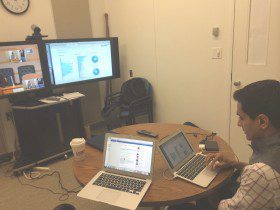 Imagine being in an office in any major city – Mumbai, Lahore, or Delhi – and knowing the precise health situation in a remote village, and being able to deploy solutions immediately to any problem that arises.
Imagine being in an office in any major city – Mumbai, Lahore, or Delhi – and knowing the precise health situation in a remote village, and being able to deploy solutions immediately to any problem that arises.
This is the goal that a SAI-supported team is trying to make a reality, by using digital tools such as mobile phones and iPads. They have piloted their idea at India’s Kumbh Mela festival, and believe this type of digital disease surveillance has significant potential for public health at future events, from natural disasters to refugee resettlements.
Their research was the topic of a SAI webinar on November 17, titled ‘Mobile Health at the Nashik Kumbh Mela’ with Satchit Balsari, Chief at Weill Cornell Global Emergency Medicine Division, Faculty at the FXB Center for Health and Human Rights, Harvard T.H. Chan School of Public Health, and leader of the project.
The Kumbh Mela, a religious every 12 years on the banks of the Godavari in Nashik, was an ideal event to test their digital tool, given its scale: it is one of the world’s largest gatherings of humanity. The SAI team spent time at the festival this summer, in which they worked with a medical team to train local doctors on how to track health data of festivalgoers – all in real time.
The work built upon their research at the 2013 Kumbh Mela in Allahabad, where they initially piloted their disease surveillance tool on iPads. An estimated 100 million people visited the festival over the course of 55 days to bathe in the holy rivers, posing many public health risks, from stampedes to the spread of disease.
While designing an app to track data at the festival, Balsari and his team focused on simplicity, which is vital for implementing mobile health interventions. With support from government administrators, as well as UNICEF, Colgate, and other institutions in India, the team was able to get the digital tools into the hands of 100 physicians across 35 sites during the festival.
Using an app with a simple interface, each physician could record an ID number, age, gender, and ailment for each patient they saw. With only one hour of training for each doctor, the team collected 40,000 patient records on the busiest bathing days – an average of 4,000 data sets per doctor.
Using all of this “extraordinarily rich” data, the team set up an interactive dashboard, available on smart phones, to see the distribution of patients organized by age, location, gender, disease, and disease frequency all in real time. “What was unique was that the tool was interactive,” Balsari explained. “The government administrators were able to shift through this data in real time as patients were coming in.”
This allowed organizers to respond in real time to health situations. For example, if the organizers noticed a spike in diarrhea cases, a team of water sanitation engineers could be deployed immediately to remedy the cause of the problem.
Given the ubiquitous nature of cell phone usage in South Asia, the tool has huge potential for revolutionzing public health and bypassing traditional obstacles like lack of landline or personal computers. Simple mobile technology could also aid in refugee crisis situations by logging health information while they are on the move. Moving forward, the team looks forward to implementing the tools on a large scale throughout South Asia.
More about the project: http://www.harvardsaikumbhmela.com/
Watch the webinar:
